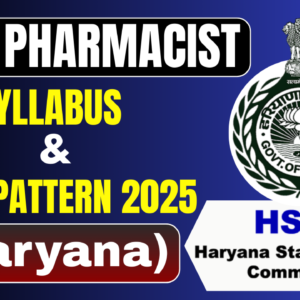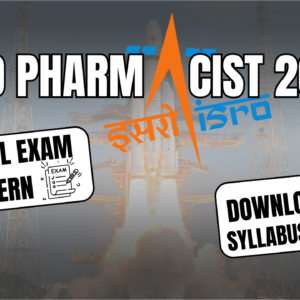WhatsApp D. Pharma Group
Join Now
Telegram D. Pharma Group
Join Now
Telegram Group Latest Pharma Jobs
Join Now
Telegram B. Pharma Group
Join Now
Telegram Medicine Update Group
Join Now
WhatsApp B. Pharma/ GPAT Channel
Join Now
ESIC Pharmacist Syllabus & Exam Pattern 2025
A Comprehensive Guide for Aspiring Pharmacists
ESIC Pharmacist Exam Pattern
The final selection for the ESIC Pharmacist position will be based on a competitive written examination. The test will consist of Multiple Choice Questions (MCQs) designed to evaluate both technical knowledge and general aptitude. The total duration of the exam is 2 hours.
| S.No. | Subjects | No. of Questions | Marks |
|---|---|---|---|
| 1. | Technical Knowledge (Pharmacy) | 100 | 100 |
| 2. | General Aptitude, Awareness & Intelligence | 25 | 25 |
| TOTAL | 125 Questions | 125 Marks | |
Detailed ESIC Pharmacist Syllabus
Part A: General Aptitude, Awareness & Intelligence
This section is designed to test the candidate’s general cognitive abilities and awareness of the world around them. It covers a broad range of topics from reasoning to current events.
Topics Covered:
- Coding-Decoding: Understanding patterns in codes and decoding messages.
- Series: Non-Verbal Series, Number Series, Alphabet Series.
- Clocks & Calendars: Problems related to time and dates.
- Arithmetical Reasoning: Solving mathematical problems presented in a logical format.
- Statements & Arguments/Conclusions: Evaluating logical arguments and drawing valid conclusions.
- Directions: Problems involving directions and distances.
- Decision Making & Data Interpretation: Analyzing data and making logical decisions.
- Visual Reasoning: Embedded Figures, Mirror Images, Cubes and Dice.
- Relations: Blood Relations and Number Ranking.
- Logical Deduction: Syllogism and Analogy.
Part B: Technical Knowledge (Pharmacy Syllabus)
This is the core component of the examination, covering the comprehensive curriculum of pharmaceutical sciences. A deep understanding of these subjects is crucial for success.
1. Pharmaceutics (I & II)
- Dosage Forms: Introduction, classification, and applications of various dosage forms. New Drug Delivery Systems (NDDS).
- Pharmacopoeias: Special reference to the Indian Pharmacopoeia (IP).
- Pharmaceutical Operations: Size Reduction, Size Separation, Mixing, Filtration, Drying, and Sterilization (moist heat, dry heat, radiation, filtration, gaseous).
- Dispensing Pharmacy: Prescriptions, Posology, and Incompatibilities.
- Formulations: Processing of Tablets & Capsules, Liquid Orals (Monophasic & Biphasic), Semi-Solids (Ointments, Pastes), and Sterile Dosage Forms (Parenterals, Ophthalmic preparations).
- Immunological Products: Sera, vaccines, toxoids, and their preparations.
2. Pharmaceutical Chemistry (I & II)
- Inorganic Chemistry: Study of key inorganic compounds like Acids, Bases, Buffers, GI agents (Antacids, Cathartics), Topical agents, and Dental Products. Includes limit tests for quality control.
- Organic Chemistry: Nomenclature, chemical structure, properties, and uses of drugs from major therapeutic classes, including:
- CNS Drugs: Anesthetics, Sedatives, Hypnotics, Tranquilizers, Antidepressants.
- ANS Drugs: Adrenergic, Cholinergic drugs and their antagonists.
- CVS Drugs: Anti-hypertensives, Anti-anginal, Anti-arrhythmic agents.
- Chemotherapeutic Agents: Antibiotics, Sulphonamides, Antifungal, Antiviral, Anti-tubercular, Antimalarial, and Anti-neoplastic drugs.
- Other Classes: Analgesics, NSAIDs, Diuretics, Antihistamines, Hypoglycemic agents, and Steroids.
3. Pharmacognosy
- Introduction: Definition, history, scope, and classification of crude drugs of natural origin.
- Quality Control: Adulteration and evaluation of crude drugs.
- Phytochemistry: A brief outline of occurrence, distribution, isolation, and therapeutic effects of alkaloids, terpenoids, glycosides, volatile oils, tannins, and resins.
- Pharmacological Study of Crude Drugs: Detailed study of drugs like Laxatives (Senna), Cardiotonics (Digitalis), Carminatives (Fennel), Antihypertensives (Rauwolfia), Antimalarials (Cinchona), etc.
- Surgical Aids: Study of fibers used in sutures and dressings (Cotton, Silk, Wool).
4. Human Anatomy, Physiology & Biochemistry
- Human Anatomy & Physiology (HAP): Structure and functions of Cell, Tissues, and all major organ systems (Skeletal, Cardiovascular, Respiratory, Digestive, Nervous, Urinary, Endocrine, Reproductive).
- Biochemistry: Brief chemistry and role of Proteins, Carbohydrates, Lipids, Vitamins, and Enzymes. Introduction to the pathology of blood and urine.
5. Health Education & Community Pharmacy
- Concept of Health: Definitions, determinants, and indicators.
- Diseases: Fundamental principles of microbiology; study of communicable diseases (causative agents, prevention) and non-communicable diseases.
- Practical Health: Nutrition, First Aid, Demography, Family Planning, and Environment & Health.
- Immunization: Epidemiology, immunological products, and the national immunization schedule.
6. Pharmacology & Toxicology
- Introduction: Scope of pharmacology, routes of drug administration.
- Pharmacokinetics: Absorption, Distribution, Metabolism, and Excretion (ADME) of drugs.
- Pharmacodynamics: General mechanisms of drug action and factors that modify drug action.
- Drug Classification: Pharmacological classification of drugs acting on CNS, ANS, CVS, Respiratory system, GIT, and chemotherapeutic agents.
7. Pharmaceutical Jurisprudence
- Legislation: Origin and nature of pharmaceutical legislation in India.
- Key Acts & Rules:
- The Pharmacy Act, 1948: A general study.
- The Drugs and Cosmetics Act, 1940 and Rules, 1945: Definitions and study of schedules.
- The Drugs and Magic Remedies (Objectionable Advertisements) Act, 1954.
- The Narcotic Drugs and Psychotropic Substances Act, 1985.
- Ethics: Principles and significance of professional ethics for pharmacists.
8. Drug Store, Business Management & Hospital Pharmacy
- Drug Store Management: Introduction to trade, industry, and commerce. Inventory control techniques (ABC, VED analysis), drug house management, and sales promotion.
- Accounting: Introduction to accounting concepts, cash book, and financial statements.
- Hospital Pharmacy: Definition, functions, and objectives. Drug distribution systems, Pharmacy Therapeutic Committee (PTC), Hospital Formulary, and surgical dressings.
- Clinical Pharmacy: Introduction, modern dispensing aspects, drug interactions, Adverse Drug Reactions (ADRs), and drug-induced diseases.
| Important Links | |
|---|---|
| Download Official Syllabus PDF | Click Here |
| Official ESIC Website | Click Here |
MORE :Download UP NHM Pharmacist Syllabus PDF: Complete Allopathic Exam Pattern
<<<<<<<<<<<<JOIN US>>>>>>>>>>>>>>>>
| Subscribe our PHARMACY INDIA YouTube Channel for more Pharma Updates | Click Here |
| Follow us on Instagram | Click Here |
| Download PHARMACY INDIA MOBILE APP from Google Play Store | Click Here |
| Follow us on LinkedIn | Click Here |







One thought on “ESIC Pharmacist Syllabus 2025: Download PDF, Detailed Exam Pattern & Topics”